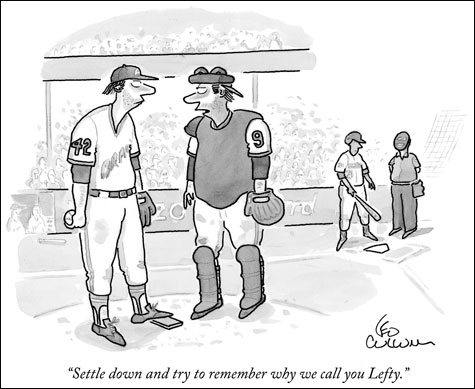
© The New Yorker Collection 2005 Leo Cullum from cartoonbank.com. All Rights Reserved.
The first pitcher/catcher cartoon in the New Yorker was also the simplest. Drawn by Garrett Price, in the June 14, 1941, issue, it depicts a catcher, decked out in the tools of ignorance, face mask still on, approaching his pitcher for a powwow.
His advice: “Strike him out.”
“I’ve always loved that one,” says New Yorker (and, we should note, Boston Phoenix) cartoonist David Sipress. “When the manager or the catcher go out to the mound to talk to the pitcher, everyone in the world, on some level, is thinking, ‘What the fuck? What in the world could possibly be useful or relevant in what he’s saying?’ ”
This past June, Sipress drew another one-panel for the New Yorker on the same subject. Standing on a sandy mound in the middle of Shea Stadium, a right-hander complains to his backstop: “I know I could keep my slider down if they would just fire the manager.” (For those not up on the minutiae of New York baseball, that’s a sly commentary on the travails this summer of since-canned Mets skipper Willie Randolph.)
Between Price and Sipress’s cartoons, there have been at least 20 other visits to the pitching rubber in the pages of the New Yorker over the years.
In April 2001, Michael Crawford made light of Orlando “El Duque” Hernandez’s remarkably acrobatic wind-up. “Gimme a hand,” the Yankees righty, his cleat lodged inside his elbow, said to his approaching battery mate. “I’m stuck.”
In October 2006, Leo Cullum imagined a catcher’s novel remedy for a bases-loaded jam: “Let’s go slider, fastball, curve, beanball, fight, ejection, shower, beer.”
This past June, Danny Shanahan sketched a pitcher peering plateward, a pigskin in hand, about to go deep. “There’s your problem,” the catcher opined.
Cartoonists often indulge in certain visual tropes, over and over again, notes Sipress. The Grim Reaper. Aliens. Cats and dogs. Snowmen. The Pearly Gates. Medieval prisoners hanging from shackles in dungeons. The wild-eyed street prophet wearing a sandwich board.
The pitcher-catcher conversation is just another example of that grand tradition. In fact, Sipress sees the pitching mound as analogous to another classic set piece. “The mound is a little like a desert island, in that there are these two people in an isolated place.”
I suggest that two people talking in private, each counting on the other in an intimate codependent relationship, suggests another cartoon cliché: the husband and wife in bed. Sipress agrees, adding that “it’s like two people in bed in the middle of a stadium. The absurdity of them having a private conversation in the most public arena is ultimately what’s so funny.”
Invite the Ump
Reached in Manhattan, New Yorker cartoon editor Robert Mankoff says the magazine’s fabled fact-checking doesn’t stop at the margins of the text layout. Cartoons get scrutinized, too.
In Sipress’s Mets cartoon, for instance, the pitch was initially called a curveball — “but we determined that it’s the slider you wanna keep down,” says Mankoff, “so it got changed.”
But far beyond any factual accuracy, of course, a cartoon must be funny. And that’s why cartoonists so often walk that fine inky line between the familiar and the cliché.